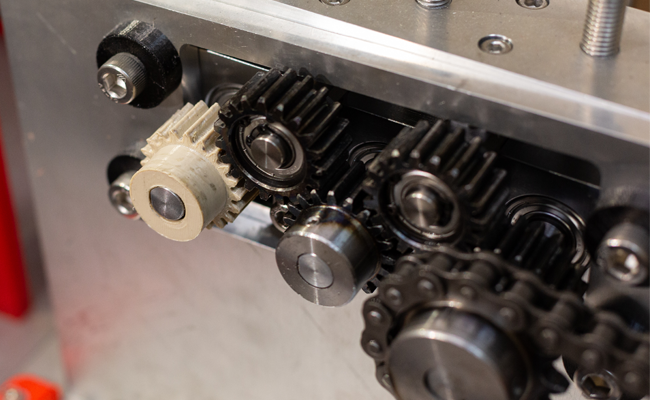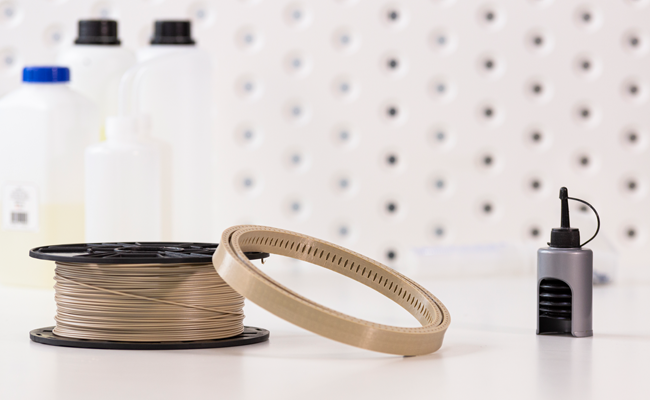Polish 3D printer manufacturer Zortrax has launched its new space-grade Z-PEEK 3D printing filament.
Created in partnership with the aerospace sector, the PEEK-based material offers an impressive blend of radiation, temperature, and abrasion resistance. Designed for use with the company’s Endureal FDM 3D printer, Z-PEEK is reportedly “one of the strongest polymers on the planet”, delivering a strength-to-weight ratio similar to that of stainless steel.
Various global space agencies have already used the material with a view for space missions via a series of thermal vacuum tests and long-exposure tests, with applications in space systems, out-of-cabin aircraft components, and other high-performance mechanical components.
Michał Siemaszko, Head of R&D at Zortrax, states, “Introduction of Z-PEEK is the result of a long cooperation with our partners in the space industry. The capability to 3D print with this material is a game changer for any enterprise willing to build cost-effective, affordable spacecraft and for large space agencies seeking to bring the cost of space exploration activities down.”

The Z-PEEK 3D printing filament
Although intended for space components, the jack-of-all-trades nature of Z-PEEK makes it a great choice for a whole host of demanding industries. The 3D printing filament sports a tensile strength of 100MPa, an elongation at break of 28%, and a flexural strength of 130MPa. Users can also co-extrude Z-PEEK alongside Z-SUPPORT HT, the company’s own breakaway support material.
PEEK is resistant to radiation, extreme temperatures, and long-term abrasion. According to Zortrax, the material can operate between 250°C and -100°C, and survive over 22 million cycles in a PEEK-steel gear pair running at 1600rpm.
Siemaszko adds, “Z-PEEK can also find applications in the oil industry, aerospace, nuclear energy and numerous other high-tech fields. With excellent thermal properties, resistance to radiation and a strength-to-weight ratio comparable to stainless steel, Z-PEEK redefines the boundaries of what polymer extrusion-based 3D printers can do.”

3D printing for the space sector
Due to the lack of atmosphere, conditions in space can be particularly challenging for even the most resilient of engineering materials. Parts on the surfaces of spacecraft are exposed to temperatures ranging from 140°C to -100°C, depending on whether or not they are facing the sun. There is also the issue of constant radiation and atomic oxygen bombardment, which can deteriorate a material rapidly if there is no shielding in place.
To test PEEK’s space readiness, the Japanese Space Agency has previously sent samples of the material to the International Space Station as part of the MPAC & SEED experiment. The samples were exposed to a Low Earth Orbit environment with no shielding for over 46 months, and showed no significant signs of mechanical degradation. As such, PEEK already sees extensive use in several space missions today.
Naturally, Zortrax also wanted to determine whether the 3D printing process would have any effect on the performance of the material. The company partnered with the European Space Agency (ESA) back in October 2020, when Z-PEEK models 3D printed on an Endureal system were sent to ESA’s ESTEC facilities in the Netherlands.
ESA conducted a series of thermal vacuum tests on the 3D printed parts, including 500 temperature cycles between -70°C and 130°C. According to Zortrax, its material “passed with flying colors”, with post-experiment CT scans revealing no mechanical or structural degradation.

With materials like Z-PEEK, we’re seeing polymer 3D printing slowly infiltrate the space sector. In the metal 3D printing field, Austrian R&D firm RHP Technology recently 3D printed a set of demonstrator parts that could form the ‘eye’ of the ESA’s new space telescope. Dubbed the Advanced Telescope for High-ENergy Astrophysics (Athena), the long-range X-ray telescope is being built to map hot cosmic gasses and black holes.
Elsewhere, propulsion system manufacturer Aerojet Rocketdyne recently announced that an upgraded version of its RL10 rocket engine had successfully passed a series of NASA hot-fire tests. During the trials, the company’s new RL10C-X upper-stage engine, which features a 3D printed injector and combustion chamber, demonstrated ignition and long-term durability within in-space simulations.
Subscribe to the 3D Printing Industry newsletter for the latest news in additive manufacturing. You can also stay connected by following us on Twitter, liking us on Facebook, and tuning into the 3D Printing Industry YouTube Channel.
Looking for a career in additive manufacturing? Visit 3D Printing Jobs for a selection of roles in the industry.
Featured image shows a 3D printed gear assembly operating at high speed under significant load. Photo via Zortrax.


